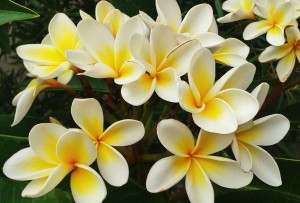
Frangipani
-Plumeria
- Frangipani also known as plumeria, is a genus of flowering plants in the subfamily Rauvolfioideae, of the family Apocynaceae.
- Most species are deciduous shrubs or small trees.
- The species variously are endemic to Mexico, Central America, and the Caribbean, and as far south as Brazil and north as Florida (United States), but are sometimes grown as cosmopolitan ornamentals in warm regions.
USES:-
- The rich, strong, and exotic fragrance of frangipani essential oil is used widely in perfumery
- Natural astringent traits aids in moisturising the dry skin making it soft, supple, and glowing
- The deep cleansing activity of this oil aids in clearing impurities, dirt from within the skin and unclog pores
- Potent anti-inflammatory and purifying properties of frangipani essential oil is valuable in fading skin pigmentation and makes the skin blemish-free
- The astringent property is valuable in strengthening hair follicles and safeguard the hair from UV damage and keep the scalp hydrated and averts dandruff
- The sedative effect of frangipani essential oil is used as an inhaler or diffusing oil to calm the mind, relieve stress, and induces a sound sleep
Cultural & Historical Importance:
- In Southeast Asia the plumeria tree and flower are considered sacred.
- A relief in the Penataran temple ruins in East Java shows a plumeria tree with its distinct flower petals and skeleton-like branches.
- A relief in the Borobudur temple, at the west side 1st zone, also depicts plumeria.These reliefs were created before European exploration. Borobudur was constructed in the 9th century and Penataran in the 14th century. Taken together, their dates fail to establish when plumeria came to Southeast Asia.
- In Mesoamerica, plumerias have carried complex symbolic significance for over two millennia, with striking examples from the Maya and Aztec periods into the present. Among the Maya, plumerias have been associated with deities representing life and fertility, and the flowers also became strongly connected with female sexuality. Nahuatl-speaking people during the height of the Aztec Empire used plumerias to signify elite status, and planted plumeria trees in the gardens of nobles.
- Indian incenses scented with Plumeria rubra have "champa" in their names. For example, nag champa is an incense containing a fragrance combining plumeria and sandalwood. While plumeria is an ingredient in Indian champa incense, the extent of its use varies between family recipes. Most champa incenses also incorporate other tree resins, such as Halmaddi (Ailanthus triphysa) and benzoin resin, as well as other floral ingredients, including champaca (Magnolia champaca), geranium (Pelargonium graveolens), and vanilla (Vanilla planifolia) to produce a more intense, plumeria-like aroma.
- In the Western Ghats of Karnataka, the bride and groom exchange garlands of cream-coloured plumeria during weddings. Red-colored flowers are not used in weddings. Plumeria plants are found in most of the temples in these regions.
Plantation:-
- Watering
The plant prefers regular water during its growth cycle but does not require watering during the winter months. However, it should be kept evenly moist throughout its life cycle so that roots will develop properly without damage from drought conditions.
- Reproduction
You can use both cuttings and seeds to propagate frangipani. As the plants contain a poisonous sap, ensure you wear gloves when handling the cuttings and pruning. Pollination is essential to Plumeria so that fruit with seeds can form.
- Location
As frangipani hails originally from tropical regions, its best performance will be in the tropics and sub-tropics.
- Temperature
Keep temperatures indoors 26 to 32°C. If that temperature is too high for indoor living, the Plumeria will do just fine with daytime temperatures of 23°C and night temperatures of 15 to 21°C.
- Diseases and pests
Frangipani rust, also known as Coleosporium pluymeriae, is a fungal plant disease that affects frangipani trees in Australia. It is spread by spores being picked up by the wind and implanted on damp leaves. There is no cure and no sprays are registered against it. To manage the spread of the disease, it is important to remove infected leaves as soon as possible and not to shake them as you do so. No products are registered specifically against it, but myclobutanil and copper are registered for rust in ornamentals.
